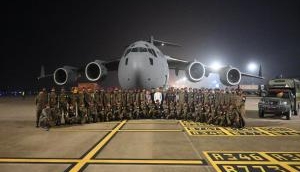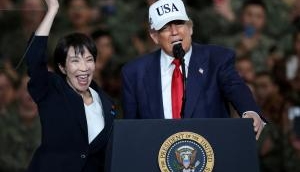
China is increasing its defense budget yet again, this time by 8.1% for the year ahead. China thus remains the second highest spender on its military in the world, eclipsing Russia but still far behind the USA.
China's defense spending, announced on 5 March at a National People's Congress (NPC) session where the Ministry of Finance unveiled its national budget, amounts to RMB1.107 trillion (USD175 billion). This is the fastest increase in the past three years as China seeks to spread its reach farther around the world as it performs a new range of missions.
Premier Li Keqiang, who delivered the budget in a speech lasting around two hours with President Xi Jinping looking stoically on, said China would "advance all aspects of military training and war preparedness, and firmly and resolvedly safeguard national sovereignty, security and development interests".
This phrase "war preparedness" is an oft-repeated one, but China refuses to say with whom the People's Liberation Army (PLA) is preparing to go to war. Certainly, such a phrase is alarming coming from an authoritarian state that has shown willingness to disregard international regulations and norms.
In terms of actual figures, China's 2018 defense budget heralds a greater increase than in 2017, when the budget grew by 7% to RMB1.044 trillion (USD151.5 billion). The year before that, in 2016, the budget expanded 7.6%, the slowest pace since 1991. That had been the first time in many years where Chinese military expenditure did not grow by double-digit figures.
This latest boost of 8.1% signals that Chinese spending should remain in the single digits for the foreseeable future, certainly not least due to stagnating gross domestic product (GDP) growth. This year the government predicted GDP would rise 6.5%, which is the same level that had been expected for 2017 - in fact, China achieved 6.9% GDP growth in 2017, if official figures are to be believed.
It is notable that military expenditure growth at a figure of 8.1% is exceeding GDP growth of 6.5%. Li argued that the defense budget was "fitting given the fact that China's economy is transitioning from a phase of rapid growth to a stage of high-quality development".
This seems slightly paradoxical when NPC spokesman Zhang Yesui explained yesterday that China would adhere to a "path of peaceful development" and that, "With a defense policy that is defensive in nature, the development of China will pose no threat to any other country."
Add to this Premier Li's admonition, "Faced with profound changes in the national security environment, we must treat the party's goal of building stronger armed forces for the new era as our guide."
Li, in his speech, lauded the rejuvenation of the PLA. He concluded, "Over the past five years, under the leadership of the Party Central Committee and the Central Military Commission, we have embarked on a new stage in strengthening and energizing the armed forces. We have developed a military strategy for new conditions; convened the Gutian military political work meeting; and taken extensive steps to see that the armed forces are built on political loyalty, strengthened through reform and technology, and run in accordance with law."
Gutian is a township in Fujian Province, and it was a revolutionary base where Mao convened a meeting in 1929 not long after the Nanchang Massacre. Beginning in 2014, Xi initiated a political meeting there to build on communist and revolutionary history.
Indeed, loyalty to the Communist Party of China is a steady drumbeat for Chinese citizens and for the PLA in particular. Li, for example, called for unity between the government, military and people to be as "strong as stone".
In his summary, Li continued, "As a result, our people's armed forces have achieved a remodeling of their political ecosystem, of the way they are organized, of the structure of their forces, and of their conduct and image. We have undertaken major missions involving the protection of maritime rights, countering terrorism and maintaining stability, disaster rescue and relief, international peacekeeping, escort services in the Gulf of Aden, and humanitarian rescue."
Further, "With the cooperation of all those involved, we have basically completed the task of reducing the armed forces by 300,000 troops. Military equipment has been significantly modernized, and we have deepened military-civilian integration. The people's armed forces, full of new drive, have taken solid strides toward building themselves into a powerful military with Chinese characteristics."
After slashing 300,000, the PLA now contains two million personnel. Unfortunately, China's budget continues to failto provide any breakdown between the PLA's four services (i.e., the ground forces, navy, air force and rocket force). This lack of transparency causes continued angst and uncertainty overseas.
It is little surprise, then, that the Pentagon's 2017 annual report on China's military stated, "Using 2016 prices and exchange rates, the Department of Defense (DoD) estimates that China's total military-related spending for 2016 exceeded $180 billion; however, it is difficult to estimate actual military expenses, largely due to China's poor accounting transparency."
Given that China declared a defense budget of USD146 billion in 2016, US estimates put real spending at least 23% higher than announced. If the same ratio is used for 2018's figure, China's defense spending could be around the USD215 billion mark.
Compared to the Pentagon, the Stockholm International Peace Research Institute (SIPRI) is less cautious in its estimate. Indeed, SIPRI calculated that China's actual spending in 2016 was some 55% more than what was officially stated.
The Pentagon document released in mid-2017 complained, "In addition, China's published military budget omits several major categories of expenditure, such as R&D and the procurement of foreign weapons and equipment." Indeed, China has been buying weapons such as Su-35 fighters and S-400 air defence missile systems from Russia.
No matter what the true figure is, China still trails the USA by a long way in terms of military expenditure. President Donald Trump proposed a FY2019 budget request for the DoD for USD686 billion, with extra billions requested for operational requirements.
NPC spokesman Zhang Yesui also said yesterday, "A large part of the growth of the defence budget is to make up for the low military spending in the past and is mainly used to upgrade equipment and improve the welfare of servicemen and women, and the living and training conditions of grassroots troops." However, this does not reveal anything, since all militaries spend their money on these three same areas.
China is investing heavily in mechanization and informatization to upgrade its military. Thus, technologies such as aircraft carriers (nuclear-powered carriers are a near certainty), nuclear-powered submarines, stealth fighters, ballistic missiles, missile defence systems, space-based capabilities, quantum communications and artificial intelligence (AI) are all being heavily funded. Furthermore, money saved on 300,000 jobs that were cut can also be reinvested in equipment and technology.
Quoted by Shephard Media, a defence publisher based in the United Kingdom, Collin Koh, a research fellow at the Institute of Defence and Strategic Studies at the S. Rajaratnam School of International Studies (RSIS) in Singapore, outlined some implications of China's defence budget announcement.
He said, "The increase in budget will mean the PLA will continue to plough more resources into not just its modernization, but structural reforms. First, persisting in the current spate of replacing ageing, legacy assets with new ones, especially those that allow the PLA to project forces farther afield. Second, more money for R&D on niche military technological areas such as autonomous/unmanned systems, artificial intelligence and hypersonic weapons, just to name a few. These two aspects not only facilitate PLA modernization but also potentially posit China for a stronger place in the global mil-tech market. In other words, it also helps with raising export prospects."
The Singaporean academic added a final result: "Third, and this is most observable - the PLA will be able to keep up with the current operational tempo for peacetime training and exercises, including sustaining and raising PLA air and naval sorties for so-called 'far seas' training."
Chinese aircraft and ships have been making increasingly frequent forays into the Western Pacific, circumnavigating Taiwan and sailing through and remaining in the Indian Ocean.
Koh noted, "Regional countries may thus see intensified forays made by PLA air and naval forces in the regional waterways and key maritime zones. Some of these countries will look upon with no small amount of unease, for example, Japan which has already seen such forays taking place so regularly around the East China Sea and the strategic southwestern isles."
The Ministry of Finance budget also listed RMB199.11 billion for "public security", an increase of 5.5% compared to 2017. However, this figure does not realistically include full Chinese spending devoted to internal security in what is essentially a police state.
This can be discerned from the fact that the last time China openly listed its domestic security budget, which occurred in 2013, spending on the PLA was RMB740.6 billion and the domestic security budget was RMB769.1 billion. Perhaps embarrassed by the stunning amounts invested in internal policing, even more than that on the military, China has failed to give full disclosure since then.
At the beginning of this year, the People's Armed Police (PAP) was moved under the full authority of the Central Military Commission. However, the PAP remains outside the PLA's chain of command for now.
This was the first session of the NPC after plans were exposed to abolish China's two-term limit of the presidency. Xi would have been expected to step down in 2023 after completing a decade in power, according to the Chinese Constitution. However, when the change comes into effect, and it will be given that the NPC is nothing more than a rubber stamp parliament, Xi will be handed unlimited tenure.
Xi is indeed intent on making "China great again", and it seems that the PLA is perhaps one of the fastest and surest ways to make that happen. The communist party wants to realize the "strong military dream", an essential part of the rejuvenation of the Chinese nation.
--NAI







![BJP's Kapil Mishra recreates Shankar Mahadevan’s ‘Breathless’ song to highlight Delhi pollution [WATCH] BJP's Kapil Mishra recreates Shankar Mahadevan’s ‘Breathless’ song to highlight Delhi pollution [WATCH]](https://images.catchnews.com/upload/2022/11/03/kapil-mishra_240884_300x172.png)

![Anupam Kher shares pictures of his toned body on 67th birthday [MUST SEE] Anupam Kher shares pictures of his toned body on 67th birthday [MUST SEE]](https://images.catchnews.com/upload/2022/03/07/Anupam_kher_231145_300x172.jpg)






